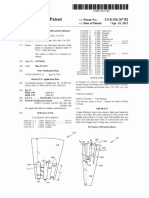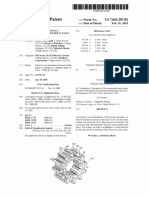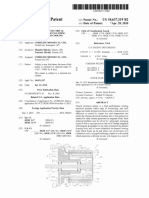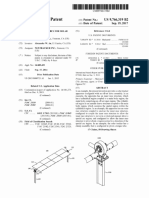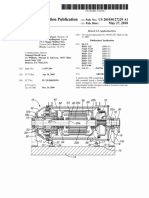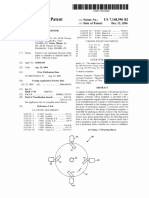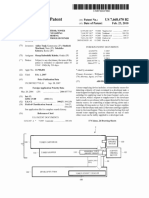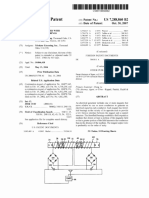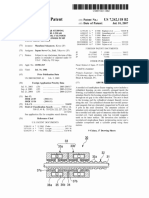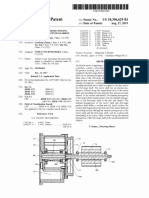0 ratings0% found this document useful (0 votes)
69 views88 pagesComputerized Tool Path Generation
Uploaded by
henokzewduCopyright
© © All Rights Reserved
We take content rights seriously. If you suspect this is your content, claim it here.
Available Formats
Download as PDF or read online on Scribd
0 ratings0% found this document useful (0 votes)
69 views88 pagesComputerized Tool Path Generation
Uploaded by
henokzewduCopyright
© © All Rights Reserved
We take content rights seriously. If you suspect this is your content, claim it here.
Available Formats
Download as PDF or read online on Scribd
You are on page 1/ 88
2) United States Patent (10) Patent No: US 8,489,224 B2
Berman et al. (45) Date of Patent: Jul. 16, 2013
(S!) COMPUTERIZED TOOL PATH GENERATION $5529 4 ¢ $1836 toni e018
+ St Romie da joie
5 1096 Jim ta Sise
(5): Mia Bran Yor I) 191356 Jim sis
Joron Oxovansld Cit Shmuel (I) Sree mae
Christopher Calderone, Leviton, PA 2 "atboe Pee a2 oot
(US). Anthony Calderon, Yardley, PA Simm A+ 1bt Aaa worn
& SInI38 A * '82000 Fskman ‘tos
CUUIUD BIS 10200 Summa Zoais0
i Saag Bie ‘S202 Shine “oe
(73) Assignee: Solideam Ltd, Or Yehuda (IL) arse ial ane
Fah ta son
(4) oti: Subject to any disclaimer, the term ofthis Fayactal wis
Palen is extended or ajusted unier 35 S391 158 BL Bacau al
Bsc. tsayey 1 don Sis 2+ 1D2006 Aer os
728to@ aise
(21) Appl. Nos 13/036,726 Tamu Hong eta wea
(Coin)
(22) Filed Reh. 28,2011 omits PUBLICATIONS
«6 Prior Publication Data nln Sesh Rta Wit Ono bth
Tsao ee 7.2012, which isd dig th poco of Apa PCT
1201200087
(51) Int-c. aa
GO6F 19/00 (011.01) (Continued)
(52) US.CL Primary Examiner —Ramesh Patel
USEC su. 700/81; 700159; 700/160; 700173
O0183; 7001190
(58) Field of Classitication Search
usec 700/159-160, 173, 181, 183, 190
29/608. 07; 408/31; 40964, 80, 84, 132; 481/64
‘See application file for complete search history.
(56) References Cited
US. PATENT DOCUMENTS.
ADSSSE A SI988 Kishi etal
ABOTIGE A VI990 Guyder
D880 A #1991. Shinorak 0018
$08,306 4 + 81991 Jepson ro 192
Spoisol A * 211902 Galler eta ro0199
EQSHK43 A * 10:1999 Mads 700176
S297022 A * Vio Watanabe 70086
S363308 A 111904 Gayder
(74) Atorn
Agent, or Firm —Sughrue Mion, PLLC
“7 ABSTRACT
An automated computer implemented method for generating
‘commands for controling «computer numerically controled
machine to fabricate an object froma workpiece the method
including the steps of selecting a maximum permited
engagement angle between a rotating euting tol and the
workpiece, selecting a minimum permitted engagement
angle between the mating eutng tool and the workpiece,
and configuring a too path for the tool relative to the work
piece in which the engagement angle gradually varies
hetwoon the maximum permitted engagement angle and the
rinimum permitted engagement angle.
£80 Claims, 61 Drawing Sheets
US 8,489,224 B2
Page 2
USS. PATENT DOCUMENTS. BOIVOLT862 AL* 712011 Diehleta 00187
7451013 B2* 11/2008 Coleman tal 0173 (OTHER PUBLICATIONS,
7871490 B2* 82009 Diehlet al. 70173
703588 B2* 42010 Honget a. ‘7o0'61 _Masinse. Toll Path Strategies for high Speed Machining. Modem
7831332 B2* 112010 Dell 00190 Machine Shop (Fb. 15,200} cieved on Jl 9, 2012} Revived
000834 B2* 8/2011 Diohlet a 700/190 fom the interes
‘20080265085 Al 10/2008 Dich etal
DOIMOIOISS9 AL 72010 Diehlet a * citod by examiner
US. Patent Sul. 16, 2013 Sheet 1 of 61 US 8,489,224 B2
US. Patent Sul. 16, 2013 Sheet 2 of 61 US 8,489,224 B2
102
100
Yo
O:
1B
FIG.
104
12
US. Patent Jul. 16, 2013 Sheet 3 of 61 US 8,489,224 B2
US. Patent Jul. 16, 2013 Sheet 4 of 61 US 8,489,224 B2
US. Patent Sul. 16, 2013 Sheet 5 of 61 US 8,489,224 B2
US 8,489,224 B2
Sheet 6 of 61
Jul. 16, 2013
US. Patent
ve
US. Patent Sul. 16, 2013 Sheet 7 of 61 US 8,489,224 B2
US 8,489,224 B2
Sheet 8 of 61
Jul. 16, 2013
US. Patent
US. Patent Sul. 16, 2013 Sheet 9 of 61 US 8,489,224 B2
US 8,489,224 B2
Sheet 10 of 61
Jul. 16, 2013
US. Patent
wa
Sz
US. Patent Sul. 16, 2013 Sheet 11 of 61 US 8,489,224 B2
US 8,489,224 B2
Sheet 12 of 61
Jul. 16, 2013
US. Patent
US. Patent Sul. 16, 2013 Sheet 13 of 61 US 8,489,224 B2
FIG. 11-1
m
US 8,489,224 B2
Sheet 14 of 61
Jul. 16, 2013
US. Patent
Z-lt
“Old
out
US 8,489,224 B2
Sheet 16 of 61
Jul. 16, 2013
US. Patent
95
US 8,489,224 B2
Sheet 18 of 61
Jul. 16, 2013
US. Patent
c-mL “Old aul
US 8,489,224 B2
Sheet 20 of 61
Jul. 16, 2013
US. Patent
US 8,489,224 B2
Sheet 22 of 61
Jul. 16, 2013
US. Patent
US 8,489,224 B2
Sheet 24 of 61
Jul. 16, 2013
US. Patent
US 8,489,224 B2
Sheet 26 of 61
Jul. 16, 2013
US. Patent
O6t
c—-Ol
“Old
761
US 8,489,224 B2
Sheet 28 of 61
Jul. 16, 2013
US. Patent
US 8,489,224 B2
Sheet 30 of 61
Jul. 16, 2013
US. Patent
Li QL 9b
veh
Pelz.
Z0%
US 8,489,224 B2
Sheet 32 of 61
Jul. 16, 2013
US. Patent
US 8,489,224 B2
Sheet 34 of 61
Jul. 16, 2013
US. Patent
1617 O61
lz
eH
sl
az vie
US. Patent Jul. 16, 2013 Sheet 35 of 61 US 8,489,224 B2
US. Patent Sul. 16, 2013 Sheet 36 of 61 US 8,489,224 B2
402
400
x“
FIG. 2B
US 8,489,224 B2
Sheet 37 of 61
Jul. 16, 2013
US. Patent
US 8,489,224 B2
Sheet 38 of 61
Jul. 16, 2013
US. Patent
US. Patent Sul. 16, 2013 Sheet 39 of 61 US 8,489,224 B2
Va 400
FIG. 2D-—2
US 8,489,224 B2
Sheet 40 of 61
Jul. 16, 2013
US. Patent
L-4az “Old
ozr—
US. Patent
Jul. 16, 2013 Sheet 41 of 61
vn
FIG. 2E-2
US 8,489,224 B2
US 8,489,224 B2
Sheet 42 of 61
Jul. 16, 2013
US. Patent
b-4@ “Old
US 8,489,224 B2
Sheet 43 of 61
Jul. 16, 2013
US. Patent
ee : a
Lat
="
é€-dé ‘Old
US 8,489,224 B2
Sheet 44 of 61
Jul. 16, 2013
US. Patent
b-9@ ‘Old
US. Patent Sul. 16, 2013 Sheet 45 of 61 US 8,489,224 B2
400
a
26-2
FIG.
US 8,489,224 B2
Sheet 46 of 61
Jul. 16, 2013
US. Patent
L-H@ “Old
US 8,489,224 B2
Sheet 47 of 61
Jul. 16, 2013
US. Patent
oor Z-HZ ‘Old
US 8,489,224 B2
Sheet 48 of 61
Jul. 16, 2013
US. Patent
L-I@ “Old
US 8,489,224 B2
Sheet 49 of 61
Jul. 16, 2013
US. Patent
oor” Z-Iz “Old
US 8,489,224 B2
Sheet 50 of 61
Jul. 16, 2013
US. Patent
l-fe “Old
US. Patent Sul. 16, 2013 Sheet 51 of 61 US 8,489,224 B2
400
ae
FIG. 2J-2
US. Patent Sul. 16, 2013 Sheet 52 of 61 US 8,489,224 B2
FIG. 2K-1
US 8,489,224 B2
Sheet 53 of 61
Jul. 16, 2013
US. Patent
Gop Z-NZ “Old
US. Patent Sul. 16, 2013 Sheet 54 of 61 US 8,489,224 B2
FIG. 2L-1
US. Patent Sul. 16, 2013 Sheet 55 of 61 US 8,489,224 B2
400
ae
FIG. 2L-2
US 8,489,224 B2
Sheet 56 of 61
Jul. 16, 2013
US. Patent
Ca) Gans) Games aay
yop Bunn ynd}n0
eS
SONS OOO
© 96re lI
es
a1 99KS “7 wadsp 303/95 “1
suonipuosf6un3no Aupoyis
aa
ayoyduoy euibu uoyp.ed9
siojouniod “9s1N >)
uae
Abyouy>al ps|
pro2wy, ABjouypay
sien}
feo
Aajausoag @-
fa uBnoy!
eu,
D>
acs)
TonoIsdObUIION
ve ‘Old
US 8,489,224 B2
Sheet 57 of 61
Jul. 16, 2013
US. Patent
Cp000 J
(02) (wm) vo
(vow) v9)
(mooy/usu) 74
“(uruu/ us)
UBIO jonjyay@
yp Bunyng yndyng-
e
ByDIAUAG |] (SIMD] W 20s) (_ AOS)
cops 000 ve)
ooo 96re' ei]
000% _s+z#6|
ees Sov uydeg
pao] 49186 wdap 399795 “|
suonipuoa Burin Apo suoripuos Bun yn9
2e
ayoiduro,
suojaupiod -261y1 >
wae
Abjouysoy gas
puozm, ABjouyoo) 64
spot FY
too GB
Anouiosg G+
ubrow
TEEN
UwonDiedgbUIUNyDOR
ag “Old
US 8,489,224 B2
Sheet 58 of 61
Jul. 16, 2013
US. Patent
P1BuI9@
yop Bur
ey
fayOITOIOD ® BA0S) (OAS }
fesiee coon ve
coors o6veeiL)
eussepOHy
Fpno yo1as “7
000% _avzv'6[)
Sddv| sndeg
udap y09I95 "1
suorypuoa Suny
2B
ayodw9y
n> fypon|fsuorypuo> Sugino
‘ouiDu_wonDzadg
suoyouns0d “351W
punzy\ Bjouypay
spre
eo, GE
Anjousoeg @-!
BOUL
wonoredgSumiyo0"
o¢ “Old
US 8,489,224 B2
Sheet 59 of 61
Jul. 16, 2013
US. Patent
(ido an09)
Cae) ams) GRR aS
sovee ooo vePy
ooo s6ve'81L]
oz _aver'6L]
Sd0¥)
og
ayoydwoy,
‘uibu uojosedg
sejauoind “291n
ur
Abjouypay
puoziy, K6jouyo0y
spna)
reo,
kxyaunag >!
now
OUTS,
oRDISdQBUNIDON
d¢e ‘old
US 8,489,224 B2
1
COMPUTERIZED TOOL PATH GENERATION
FIELD OF THE INVENTION
‘The present invention relates to systems and methodolo- 5
tes for automated tool path design and computer controlled
machining and prouts produced hereby
BACKGROUND OF THE INVENTION
»
‘The following publications are believed to represent the
‘eurrea sate ofthe at an ae hereby inconporated by refere
US, Pat, Nos. 4,745,588; 4,907,164; 5,363,308; 6.363,
208; 6.447.223; 6,591,158; 7451, 013; 7.577490 and 7.831
33%; and
US Published Patent Application No,: 200510256004.
‘SUMMARY OF THE INVENTION
‘The present invention seks to provide systems an meth-
‘odologies for automated toa ath design and computer coa-
trolled machining and procs rodced thereby.
‘There is thus provided in accordance with 2 prefered
«embodlimentof the present invention anawtomated computer
implemented method for generating commands foe coneol
ling computer numerically controled machine o fabricate
abject froma workpiece the method inching the steps oF
selecting maximum permitted engagement angle berween.a
rotating outing to! an the workpiece selecting «minimum
permifted engagement angle between the rating eating 0]
and the workpiece, and configuring a tool path forthe tol
relative tothe workpice in which the cgagement angle
tnadully varies beteen the maximum permite engaae-
tment angle and the minimum permited engagement angle. 5
Tnaccorlance witha prefered embedment ofthe present
invention, rspoasive to consideration of at lea one a eae
dcteristis of the computer merical controlled machine,
rotating cutting tool and material of the woekpoce the con:
figuring also includes minimizing, subjet 10 other con
straints, therate ofchangeo! the engagement angle over tine,
‘radully changing the feed speedo the tool comesponding
tothe changing engagement angle, msntining a generally
‘constant workload om the tool, and minimizing the cost of
fabricating the object, whereby he cost isa combination of 45
the cost of operating the machine forthe uration of the
fabrication andthe ostof the wear initeon the too during
the fabrication
Preferably, the tool path includes a plurality of tol path
segments and configuring a to! path ineides recursively
configuring each of the tol path seymeats, and wherein,
responsive tocoasidention fal eastoneafchareterisiesof
the computer numerically controlled machine, rotting ct
ting tool and materi of the workpiece, configuring each of
the tool path seymeats als eludes minimizing, subjet to
‘other constins the rate of change ofthe engagement angle
‘overtime, gradually changing the feed spood of the tol
‘corresponding to the changing engagement angle, meintain-
ing a generally consant work lod onthe tol, nd asinine
ing the cost of machining the each ofthe tool path seamen,
‘whereby’ the cost ia combination of the cost of operting the
racine foe the duration ofthe machining andthe cst the
‘wea inlited onthe too ding the machining
Aakitionally each of the tool path segments inches
plurality af too path subsegmeats and recursively eontig-
dng each of the tol path segments inches ecusively con-
figuring cach of the tool path subsegments, and wherein
»
2
responsiveto consideration ofa east one of characteristics of
the computer numerically coutlled machine, rotating eut-
ting tool and material ofthe workpiece, the configuring each
ofthe to! pat subsepments alsa incldes minimizing, sub-
ject olbercastrains, the rate of change ofthe engagement
angle overtime, gradually changing the feed specd of the tol
corresponding the changing engagement angle, maintain-
nga generally constant work lod on the too, and minimiz«
ing the cost of machining the each of the tool path subsea
ments, whereby the cost is a combination of the cost of
operating the machine forthe duration ofthe machining and
the costo the wear inficteon the tool during the machiaing,
‘There is also provided in accordance with another pre
ferred embodiment of the present invention # method! for
machining a workpiece employing a computer conteolled
‘machine too, the method including directing the too along 8
‘ool path wherein an engagement angle between the too ad
the workpioce gradually varies between a preselocted maxi-
rium permited engagement angle and a preselected mini-
mum pemnited engagement angle.
‘There is further provided in accordance with yet another
prefered embodiment ofthe resent invention an automated
computerimplemented apparatus for generating commands
Jor cootrling a computer numerical conmlled machine to
Jabricatean object froma workpiece, the apparatus including
«tool path configuration engine operative Toe configuring 8
tool path for a tool relative tothe workpiece ia whieh the
engagement angle gradually varies between a preselected
raximum permitted engagement angle and a preselected
rminimum permitted engagement angle.
Preferably the configuring includes minimizing, subjetto
other constraints, the rate of change ofthe engagement angle
overtime, Preferably, te configuring also includes gradually
caging the feed speod of the tol coreesponding © the
changing engagement angle. Preferably, the configuring is
also operative to maintain a generally constant workload on
the tool, Preferably, the configuring is also operative to mini=
mize the cost of fabricating the object, whereby the cost is 2
combination of the cost of operating the machine forthe
uration ofthe fabricationand the cost ofthe wea iflictedon
the tool during the fabrication, The prefered features refer-
enced in this paragraph are also applicable to all appropriate
claimed embodiments of the present invention.
Preferably, te tol path includes plurality of too! path
segments and configuring a tool path includes recursively
configuring exch of the tool path segments, and wherein the
configuring each of the tool path segments also includes
‘minimizing, subject o other consists, the ateof change of
the engagement angle overtime, gradually changing the feed
speed ofthe tool corresponding tothe changing engagement
angle, maintaining a generally coustat workload onthe oo,
snd minimizing the costof machining theeachof te tol path
segments, whereby the cost is a combination of the cost of
operating the machine forthe duration ofthe machining ae
the cost ofthe wear inflicted onthe ool during the machining
The preferred features refereed inthis paragraph are also
applicable to all appropriate clsimed embodiments of the
present invention,
Preferably, each ofthe too! path segments includes a plu-
rity of too! path subsegments and recursively configuring
exch ofthe foo path segments incdes recursively configt=
Jing each ofthe tol path subsepments, and wherein the con-
figuring eachof the oo! path subsegments als includes mini-
nizing, subject to other constrains, the rato of change ofthe
engagement angle overtime, gradually changing the feed
speed ofthe tool corresponding othe changing engagement
angle, maintaining a generally constant workload onthe oo,
US 8,489,224 B2
3
and minimizing the cost of machining the each ofthe too pa
subsegments, whereby the cost isa combination of theeost of
‘operating the machine for the duration ofthe machining and
the costo the wea nficteon the tool during the machining,
‘The proferred features reference in this paragraph ae also
applicable to all appropriate claimed embodiments of the
preset invention,
Preferably, the configuring also includes considering at
least one of characteristics ofthe computer numerically con
trolled machine, rotating cutting tool and material of the
workpiece. The prefered feutues referenced in this para
_araph are also applicable wall appropriate claimed embod
ments ofthe present invention,
“There is yet further provided in acconlance with still
‘another prefered embodiment of the present inveation an
sutomated computer-controlled machine w fabricate an
‘object from a workpiece, the machine inchuding a conrller
‘operative for dtectinga rotating cutting tol along a too path
relative to the workpiece in Which an engagement angle 2
between the tol and the workpiece gradually varies between
‘preselected maximum permitted engagement angle and a
preselected minimum permitted engagement angle
‘There is yet further provided in accordance with still
another prefered embodiment of the present invention an
‘object fabricated from a workpiece machined using a com-
puter controlled machine tol by directing 2 ating cuting
‘ool along too! path wherein an engagement angle between
the rotating euting tool and the workpiece gradually varies
between a preselected maximum permitted engagement
angle and « preselected minimum permitted engagement
angle
‘There is yet frther provided in accordance with sill
nother prefered embodimeat of the resent invention an
tuomated computerimplemented method for generating
‘commands for controlling a computer numerical contolled
machine to fabricate an object from a workpiece the method
including he stepsof selecting a regionot the workpiece tobe
removed by a rotating cuting tol, configuring an asymmet-
rie spiral to! path forthe rotating cutting tol inthe epion of
the workpiece, which asymmetric spiral ool path maximizes
the portion of the region of the workpiece which is removed
by the roating cutng tool moving along the asymmetric
spiral tool path.
Preferably, the method also includes configuring at least
‘one trochoidal-lik tool path forthe rotating cutting too in a
remaining portion ofthe region of the workpiece which is,
remuved by the tool moving along the tochoidal-lke tol
path
Preferably, the method also includes selecting maximum
permitted engagement angle between a rotating cutting tol
and the workpiece, selecting a minimum permited engage-
rent angle between the rotating cutting tool and the work
Piece, ane configuring the asymmetric spiral to! path an the
atleast one tochoidal-like tol path relative w the workpivce
so thatthe engagement angle gradually varies between the
maximom permitted engagement angle and the minimm.
permitted engagement ange
Preferably, responsive to consideration of atleast one of
‘characterises of the computer numerically controlled
‘machine, rotating cutting ool and material ofthe workpiece,
the configuring also includes minimizing, subject to other
‘constraints, the rate of change of the engagement angle over
time, gradually changing the feed speed ofthe tool core
sponding to the changing engagement angle, maintaining
generally constant work ladon the tool, and minimizing the
‘costo fabricating the objet, whereby the cost sa combina
4
tion ofthe cost of operating the machine for the duration of
the fabrication ad the cost of the wear inficted on th tol
during the fabrication
Preteably, the asymmetric spiral too! path includes a plu-
‘ality of spizl tol path segments, deat east one rochoidal-
like tool path includes a plurality of trochoial-tike tool path
segments, configuring an asymmetric spiral tool path
includes reeusively configuring each ofthe spital ool path
segments, and configuring atleast one tveboidal-like tol
path includes recursively configuring each ofthe rochoidal-
like tool pth segments, and wherein responsive to consider-
ation of atleast one of characteristics of thecomputer mumeti-
cally controlled machine, rotating cutting foo] and materia of
the workpiece, the configuring each ofthe tool path segments
also includes minimizing, subjectto other constraints, the rate
of change of the engagement angle over time, gradually
changing the feed speed of the tool corresponding t the
changing engagement angle, mriatsining a generally coa-
staat work load on the tool, and minimizing the cost of
machining the each of the tool path sepmients, whereby the
cost isa combination ofthe ost of operating the machine for
the duration of the machining and the cost of the wear
inflicted onthe tool during the machining.
Additionally, each of the too! path segments includes a
plurality of tool path subsegments and recursively configure
‘ng each ofthe tol path segments includes recursively con
figuring each of the tool path subsegments, and wherein
responsiveto consideration ofat eat oneof characterises of
the computer anmerically controlled machine, rotating cut-
ting tool and material ofthe workpiece, the configuring each
‘ofthe tol path subsegments also includes minimizing, sub-
jc other constrains, theate of ehange of the engagement
angle over timo, gradually changing the feod speed of the tol
corresponding 1 the changing engagement angle, maintain-
ing a generally constant work load on the tool and minimiz=
Jing the cost of machining the each of the tool path subsea
ments, whereby the cost is a combination of the cost of
operating the machine forthe duration ofthe machining and
ttecost of the wear inflicted onthe tool during the machining,
Preferably, the asymmetric spiral too! path is one of @
coaverging spiral tool path and a diverging spiral tool path
“There is Yet further provided ia accordance with still
another prefered embodiment of the present invention a
method for machining a workpiece employing a computer
controlled machine tool, the method including selecting a
region ofthe workpiece to he removed by a oating cutting
tool, and directing the too! along an asymmetie spiral tol
path inthe region ofthe workpiece, wherein the asynmeteic
spiral tol path maximizes the portion ofthe region of the
‘workpiece whichis removed by the roating cutting tool mov-
ing along the asymmetic spiral too path. Preferably, the
method aso includes divcting the eating etting oo! along
st eat one trochoidal-like ool path in remaining portion of
the region of the workpiece which is removed By the tol
‘moving along the tochoidal-like tool path,
“There is yet further provided ia accordance with still
nother prefered embodiment of the present invention an
suomated computerimplemented apparatus for generating
commands for eonvoliag a computer numerical conlled
chine to fabricate an objet from a workpicce the appara-
tus including a tool path configuration engine operative for
selecting a region of the workpiece to be removed by a rtat-
ing cuting oo, atl for configuring an asyaunetric spiral tol
path forthe rotating cutting tol in the region of the work
piece, which spiral to! path maximizes the portion ofthe
regioa ofthe Workpiece which is ramoved by the rotating
cutting too! moving along the asymmetric spiral ool path
US 8,489,224 B2
5
Preferably, the ool path configuration engine isalso opera-
tive for configuring at least one tochoidal-like tool path for
‘heotating cutting ool ina remaining porionof theregion of
‘he workpiece whichis removed by theo moving slong the
twochoidallike tool path s
Preferably, the configuring includes selecting « maximum
permitted engagement angle between a rotating cutting to!
and the workpiece, selecting 2 minimum permited engage-
meat angle between the rotating cutting tool and the work
Piece, and configuring the asymmetric spiral tol path andthe
atleast one trochoidal-like tol path relative tthe workpiece
so thatthe engagement angle gradually varies between the
‘maximum permitted engagement angle and the minimum
permitted engagement ange.
Preferably, the configuring includes minimizing, subjetto 18
‘other constrains, the rae of change ofthe engagement angle
‘overtime. Preferably, the configuring also includes gradually
‘changing the feed spoed ofthe tool coresponding to the
‘changing engagement angle. Preferably, the configuring is
also operative to maintain a generally constant work load on
the too. Preferably, the configuring is also operative to mini-
mize the cost of fabricating the object, whereby the cost is a
‘combination ofthe cost of operating the machine for the
‘duration ofthe fabrication andthe cost ofthe wearinited on
the to! during the fabreation
Preferably, the asymmetric spiral tool path includes a pla-
rally of spiral tool path segments, thea eat one tochoidal=
like tol path includes a plurality of rochoidal-tike tool path
segments, configuring an asymmetric spiral tool. path
includes recursively configuring each of the spiral tool path
segments, and configuring atleast one trochoidal-hike tol
Path includes recursively configuring each ofthe trochoidal-
like tol path segments, and wherein responsive to coasidee-
ation atleast one of characteristics ofthe computer umeri-
‘aly conitolled machine, rotating cutting tool and material oF
the workpiece, the configuring each ofthe too! path sepments
‘als includes minimizing, subject other constraints therate
‘of change of the engagement angle over time, gradually
‘changing the feed speed ofthe tool coresponding to the
‘changing engagement angle, maintaining a generally con-
sant work lood on the tool, and minimizing the ost of
machining the each of the tol path segments, whereby the
‘cost isa combination of the cost of operating the machine for
the duration of the machining and the cost of the Wear
inflicted onthe tool during the machining
Additionally, exch of the tool path segments inches a
plurality of tool path subsegments and recursively configur-
ing cach ofthe tol path segments includes recursively
figuring cach of the tool path subsegments, and wherein
responsive oconsideration ofa least one of characteristics of Sb
the computer numerically controlled machine, rotating cut-
ting tool and material ofthe workpiece, the configuring each
‘of the tool path subsegments aso ineludes minimizing, sub-
{oct toother constraints, the rateof change ofthe engagement
‘angle overtime, gradually changing te fed speed ofthe tool
‘corresponding tothe changing engagement angle, mina
ing a generally constant work load on the too, snd minimiz~
ing the cost of machining the each af the tol path subseg-
meats, whereby the cost is a combination of the cost of
‘operating the machine for the duration ofthe machining and
the cost ofthe wear infliction the tool during the machining,
Preferably, the asymmetric spiral tool pah is one of a
‘converging spiral tool path anda diverging spiral tol path
‘There is yet further provided in accordance with still
another prefered embodiment of the present invention an
‘aufomsted computer-contolled machine 10 fabricate an
‘object from a workpiece, the machine including a controller
Fa
6
operative for selecting 4 region of the woskpiese 10 be
removed by a rotating cutting tool, and for directing the
rotating cting tool along an asymmetric sia ol psi in
theregion ofthe workpiece which pra tool path maximizes
the portion ofthe region ofthe workpiece which is removed
by the rotting cutting tool moving along the asymmetric
spiral oo path
Preferably, thecontlleris ls operative for directing the
rotating cuting ool alg atleast one tochoidal-ke ool
path in a remaining portion ofthe region of the workpiece
Thich s removed by the tol moving along the tochoidl-
like too path
‘There is yet further provided in aecondance with sil
another preferred embodiment ofthe present invention an
objet fabricated rom a workpiece machined using & com-
per controlled machine tol by selecting a region ofthe
workpiece to be removed bya rating eutng tol and by
dzeting the rotating ctting tol slong an asymmetec sical
‘ool path athe region ofthe woekpgee, which pital too path
maximizsthe portion ofthe regina the workpiece whichis
removed bythe eating eutng tol moving along the asym-
rote spiral tool path
Prelerably, the objet i ibicated also by dieting the
rotting cuting tool along at ess one tehodl-ke tol
path in a remaining portion ofthe region of the workpiece
Thich is removed by the tol moving along the tochoidl-
ike tol path
‘There is yet furer provided in aecordance with sll
anoher preferred embodiment ofthe present invention an
automated computerimplemented method for generating
commands for conioling a computer numeral eontlled
machine to farcatean object froma workpiece the mth
inclodingthe stops of selotingareaionof the werkpieceto be
removed bya mating euting oa, selecting it portion of
the eon o be removed by an asymmetric spiral oo pa
and configuring at fast one tochoidal ike tol path for
removing a reniaing portion ofthe eon, and wherein the
selecting aft potion ofthe region is operative a minimize
the machining ime necessary o remove the region.
Prelerably ibe method also includes selecting maximum
permitted eagagement angle between a tol and the work-
Piece, selecting minimum permited engagement angle
between the tool and the workpiece, and configuring the
asymmiete spiral ool path and the at lest one tochoidl-
ike oo! pathrelatveto the workpiece so that the engagement
angle gradually varies hetween the maximum permited
engagement angle and he minimum permitted engagement
angle
Preferably, responsive to comidertion ofa least one of
characterises of the computer numerically. contalled
nuachine rotating euting ool and materia of the workpiece,
the configuring also includes nizing, subjet to other
constraints, the rate of change ofthe engagement angle over
time, gradually changing the fed spe of the tool core-
sponding to the changing engagement angle, maining a
severly constant work oad onthe tol and minimizing the
ost avicatng te object, whereby the ost isa eombina-
tion athe cost of operating the machine forthe duration of
the fabrication an the cst ofthe wear ilictd onthe tool
during the fabrication,
Preferably the asymmetric spiral tol path ina plo-
salty of spiral ol pth seement, the ateast one wochoidal-
like to! path aces plurality of tochoida keto! path
segmens, the configuring an asymmetric spiral tool path
inches recursively configuring each ofthe spiral ool pth
Segments, the configuring at least one tochoidal-ike tol
Path incades recursively configuring each of the ochoidl-
US 8,489,224 B2
1
like tol path segments. and wherein responsive to consider-
ation ofa leastoneof characteristics ofthe computer numeri
‘ally controled machine, rotating cuting tool nd material of
the workpiece, the configuring each of the tool path segments
‘also includes minimizing subject olher constants therate
‘of change of the engagement angle over time, gradually
‘changing the feed speed ofthe tool coresponding to the
changing engagemeat angle, maintaining 2 generally oon-
stant work od on the tool, and minimizing the ost of
machining the each of the tool path seaments, wliereby the
‘cost isa combination of the cost of operating the mache for
the duration of the machining and the cost of the Wear
inflicted onthe tool during the machining
Preferably, ese of the tool path segments includes plu
ralityof too! path subsegments and recursively configuring
‘each ofthe tool path segments includes recursively contigue-
ing each ofthe ool path subseyments, and wherein respon
sive to consideration of at last one of characteristics ofthe
‘computer numerically controlled machine, rotating cutting
‘ooland material ofthe workpiece, theconfiguringeachofthe 2
tool path subsegments also eludes minimizing, subject to
‘other constraints, the rate of change ofthe engagement angle
‘overtime, gradtlly changing the feed spood of the tol
‘soresponing tothe changing engagement ange, msintsin-
inga generally constant work lod on the oo, and minim
ing te cost of machining the cach of the tol path subsea
meals, whereby the cost is combination of he cost of
‘operating the machine forthe dation ofthe machining and
thecostof the wea infictdon the tol during te mschining.
Preferably, the asymmetric spiral tol pth is one of a
‘converging spiral ol path ae averging spiral ol path,
‘There is yet farber provided in accordance with tl
swothor prefer embodiment of the preset inveation a
method for machining 8 workpiece employing a computer
come michine to, the metbod inclding slong @
region of the workpiece to be removed by aotatngeuting
tool selecting fit potion of the repion o be removed by
asymmetric spiral ool pa, and directing the tol along at
least one trochoidablike too! pth in a remaining portion of
the region ofthe workpiece, and wherein selecting fist
postion ofthe region sapeatve to minimize the machining
Hime necessary to remove the region
‘There is yet fariber provided in accordance with stl
nother prefered embodiment of the preset vention an
‘ome computer implemented appérats fo generating,
‘commands for contin a computer numerical eontoled
machin o fabricate an objet fom a workpiece, the apara-
tus inluding tool path configuration engine operative for
selecting region of the workpieeto be removed bya rate
ing cutting tol, olectinga fst potion ofthe region to be
removed by an asymmetric spiral ol a and for configu
ing atleast one tobaial-tike tool path for removing @
remaining potion of th region, and wherein the selecting 2
fistporionof the region isoperativeto minimize the machin
ing ine necessary to remove the region.
Preferably the config ncdes selsing a mai
permitted engagement angle between rating eting tol
andthe workpiece, selecting a minimum pemiteengage-
meat angle between the rotating euting ool and the Work
piece, and configuring the asymmetric sil tool pathandthe
atleast onetrochoidel-ike tol pa elatve tothe workpiece
fo tat the engagement angle gradually varies berween the
maximum permitted engagemeat angle and the misimm
permite engagement angle
Preferably te configuring includes minimizing, sbjet io
‘other constrains the rate of change ofthe engagement angle
‘overtime. Preferably the configuring also includes radly
s
8
changing the fed speed ofthe ool corresponding wo the
changing engagemeat angle Prefebly, the configuring is
als operative to maintain generally constant work load on
the oo, Prefebly, the configuring also operative omni
mize the cost of abicating the objet, whereby the cost isa
combination of te cost of operating the mache forthe
duration ofthe fabicationandthecost ofthe wear infictd on
the tool daring the fibration
Preferably the asymmetric spiral tol path inhadesaplo-
salty of spiral tool pth seamen that east one tocboidal-
like to! path aces plurality of troche tol path
segments, configuring an asymmetric spiral tol path
inches recursively configuring each of the spiral Yo! path
Seqncus and configuring atleast one trochoidal-ike tool
put includes recursively configuring each ofthe woshoidl-
ike tool pth segneats, and wherein responsive wo consier-
ation fat estone of characteristics the compte mumed-
cally controled machine, ating cuting tol and material of
the workpieve th configuring each othe oo pat segments
alsoincudes minimizing, subjectto other constants theate
of change ofthe engagement angle over time, gradually
changing the fed speed ofthe tool comesponding. to the
changing engsgemet ange, minting @ genealy con-
stant work foad on the tol, and. minimizing the cost of
machining the exch of the tol path segment, whereby the
costiva combination ofthe cost of opening the mache for
the duration of the machining and the cost of the Wear
inflicted on the to! during the machining
Ationally, each of the tol path seymens includes a
plurality of tool path ubseyments and recursively contig
dng each ofthe too path segments includes recursively con-
figuring each ofthe tool path subsegments, and wherein
responsvetoconsidetionof at leastone ofchareteristiesof
the computer numerically controlled machine, rotating eu
ting tol and material ofthe workpiece, the coniguring each
ofthe tool path subscuments alsa inelides minimizing, sub-
ject other constrains, the rate of change ofthe engagement
angle overtime, gradually changing the feed speed of theo!
cortesponting (the changing engagement angle, maintan-
ings generally constant workload onthetool and asninizing
the cos of machining the each of the tool path subseamens
whereby the costs combination of the cost of operating the
racine forthe duration of the machining ad the cost ofthe
‘wer nlite onthe ool during the machining,
Preferably, the asymmetric spiral too! path is one of
conversing spi too path anda divering spiral tol pth
“There is yet fare provided ia secondance with sll
note prefered embodiment ofthe present invention an
automated computercontlled: machine to fabricate an
objet fom a workpiwe the machine inclu a conwoler
operative for selecting region of the woripieee to be
removed by a rottingeuting oo, selecting first portion oF
the region to be removed by an agymmetc spiral tol path
anu foe dreting the rotating euting too long atleast one
traci too! path inthe eo of the workpiece, ad
wherein the selecting a fist portion of the region is operative
to minimize the machining time necessary to remove the
region
“Thor is yet fare provided in aecordance with sill
nother preferred embodiment ofthe present invention an
object fabricated rom a workpiece machined using com-
puler controlled machine tol by selecting a region ofthe
‘workpiece to be removed by a oatngcuting tol slecting
frst potion ofthe ein to be emved by an asymmetric
spiral to! path andy directing he rotating eting ol along
at leat one tmhoida-ike tool pat in the region of the
US 8,489,224 B2
9
‘workpiece, and wherein the selecting a fst poston of the
regio s operative to minimize the machining time nevessary
to remove the region
There is yet further provided in accondance with still
‘another prefered embodiment of the present invention ans
automated computerimplemented method for generating
‘commands for controlling a computer numerical eontolled
‘machine o fabricate an object fom a workpiece by removing
portions ofthe workpiece which are aot o be included ia the
‘object, the method including the steps of considering the
‘ross section of a desired object to be fabricated from a
‘workpiece, defining isolated regions ofthe cross section on
the workpiece surface which ae not tobe removed as islands,
‘commencing configuring oF ool path in aregion not having
islands, and upon the to! path encountering an island, coa
figuring a moat tool path Which defines @ moat surounding
the island
Preferably the method also includes defining « composite
region inchiding the island, the moat surrounding the island
and regions already removed from the workpiece a a
removed region and configuring a tool path to remove a
remaining region ofthe workpiece, which remaining region
‘doesnot include the removed region,
Preferably, the method also includes selecting 2 maximum
permitted engagement angle between a tool and the work
piece, selecting minimmim permitted engagement angle
between the tol and the workpiece and configuring the moat
‘ool path relative w the workpiece so thatthe engagement
angle gradually varies between the maximum permitted
‘engagement angle and the minimum permitted engagement
angle.
Preferably, responsive to consideration of at last one of.
characteristics of the computer numerically contled
‘machine, rotating cuting tool and anateral ofthe workpiece,
the configuring also includes minimizing, subject wo other 35
‘constants, the rate of change of the engagement angle over
time, gradually changing the feed speed ofthe tol core
sponding o the changing engagement angle, maintaining &
eneraly constant work load on the tool and minimizing the
‘cost of fabricating the objet, whereby the costs combins-
tion of the cost of operating the machine fr the duration of
the fabrication aad the cost of the wear alice oa the tal
during the fabrication.
Adkiionlly the oo! paths inelude a plurality of too! path
segments and configuring the tool paths includes recursively
‘configuring each of the tool path segments, and wherein
responsive to consideration ofa eat oneof characterises of
the computer numerically conteolled machine, rotating eut-
ting tool and material ofthe workpiece, the configuring each
‘ofthe tool path segments also includes minimizing, subject. 50
‘other constrains, the rae of change of the engagement angle
‘over time, gradually changing the feed speed of the tool
‘corresponding tothe changing engagement angle, maintsin-
ing a generally constant work load on the tool, and minimiz~
ing the cos of machining the each of the too path segments,
whereby the cots combination ofthe cost of operating the
‘machine forthe duration ofthe machining andthe cos af the
‘wear inflicted on the tol during the machining.
‘Additionally, each of the too! path segments includes a
plurality of tool path subsegments and recursively config
ing each ofthe to! path sepmentsinchades recursively con
figuring each of the tool path subsegments, and wherein
responsive To consideration of at east one of characteristics of
the computer numerically controlled machine, rotating et
ting tool and marecal ofthe workpiece, the configuring each 6s
‘of the tool path subsegments aso includes minimizing. sub-
Jesttootherconsrants, the rateof change ofthe engagement
10
angle overtime, gradually changing the feed speed of theo]
corresponding to the changing engagemest angle, msintain-
inga generally constant work ad on te tol, nd minimiz-
ing the cast of machining the each of the tol path subsea
nnens, whereby the esti a combination of the east of
jperating the machine forthe duration of the machining and
thecostof the wea infietdon the tol during the machining.
There is yet further provided in scordance with st
anoiber peefered embodiment of the present invention a
mmetod for machining « workpiece employing «computer
controlled machine tel, the method inluding considering
the eros section of a desired objet to be fabricated fom a
vwrkpiee, defining isle regions ofthe cos section on
the workpiove surface which are motto beremaved as islands,
inally dieting the to! sng ato! path ina region not
having sland, and upon the tol path encountering anisland,
diretng the tol along moat oo path whichdefine moat
surrounding te island
There is yet further provided ia aocordance with sill
another prefered embodiment ofthe present invention an
automated computermplemented apparatus for generating
commands for controling a computer unsrialcontlled
machin o fabricate an object from a workpiece the appara
tus inluding too path configuration engine operative for
considering the coss Seton ofa desired objet to be fabe-
cated fom workpiece defining isolated epionso the cross
section on the workpiee surface which remot to Be emoved
as lands, commencing configuring of tot pat ina region
not having islands and upon the to! path encountering an
island for configuring a meat tool pth which defines a moat
surrounding the sland,
Preferably, the configuration engine is also operative for
defining a composite rpion inluding the island the moat
surmunidng the snd ad regions already removed fom the
‘workpieces removed reyion and foreonfgurngatoa path
to remove a remaining region of the workpiece, which
remaining region does not nce the removed region.
Preferably, the configuration engine is slso operative for
selecting amaximum permitted engagement ange between
tool and the workpiee, selecting, @ minimum permited
engagement angle between the ol aad the workpiece and for
onigriag the moat tol path relative othe workpiece so
thatthe engagement angle gradually varies between he maxi-
sum permite engagement angle and the mii peri
tod engagement anal,
Preferably, responsive to consideration of atleast one of
characterises of the computer numerically contlled
‘ache, rotting eating tol and material ofthe workpiece
the configuring also includes nizing, subjet to other
constants the rate of change of he engagement angle over
time, praualy changing the fed spe ofthe tool core-
sponding tothe changing eogagement angle, maintaining a
generally constant workload onthe tol and minimizing the
costa fahvicatng the abject, wherehy the cost isa combina
tion ofthe cost of operating the machine forthe duration of
the fabrication and the cost ofthe wear iaficted onthe tool
during he fabrication
‘Adtionally the to! paths incude a plurality of! path
segmenis and coniging ot pasincludesrecuaively Gon-
figuring each of th oo ath Segments, and wherein espon-
sive to consideration of at east ane of characteristics ofthe
computer numerically conelled machine eating eating
tooland material ofthe workpiece, the configuringeacho the
tool path segments also inehas minimizing, subject to thor
constraints, the rate of change ofthe engagement auale over
time, prualy changing the fed speed ofthe tool core-
sponding to the changing engagement angle, maintaining a
US 8,489,224 B2
generally constant work ladon the too, and minimizing the
‘costof machining the acho the tol path segments, whereby
thecostisa combination ofthe cost of perting the machine
forthe duration ofthe machining and the cost ofthe wear
inflicted on the to! dusiag the machining
Additionally, cach of the tool path segments inches a
plurality of too path subsegments and rvursively configu
ing each of the tool path segments inches ecusvely con-
figwing each ofthe tool path subseamens, and wherein
responsvetoconsiertion of aleastoneofchareterisies oF
the computer mumeially conolled machine, rotting cut
tng tool and mate ofthe workpgce the configuring each
‘ofthe tol pth subsegments lo incides minimizing, sub-
{stinother constants, the ratcof change ofthe engagement
‘angle ver time, rail changing the fee sped ofthe tol
‘onesponding (0 the changing engagement agle, maintain.
ing a generally constant workload onthe tol nd minimiz-
ing the cost af machining the cach of the tol path subsea
Ines, whereby the cost a combination of the cast of
‘operating the machine for the dation ofthe machining and
thecostof the wear infictedon the tol during the mechining.
“Thar is yet farther provided in accordance with sl
another peered embodiment ofthe presen vention an
automate! computer-
You might also like
- United States Patent Patent No.: US8 215,454 B2: Portlock Et Al 10) 45) Date of Patent Jul. 10, 2012No ratings yetUnited States Patent Patent No.: US8 215,454 B2: Portlock Et Al 10) 45) Date of Patent Jul. 10, 201213 pages
- United States Patent: (12) (10) Patent No.: US 7,109,625 B1No ratings yetUnited States Patent: (12) (10) Patent No.: US 7,109,625 B134 pages
- United States Patent (10) Patent No.: US 8,154,167 B2No ratings yetUnited States Patent (10) Patent No.: US 8,154,167 B226 pages
- United States Patent: Holtzapple Et Al. (45) Date of Patent: Feb. 16, 2010No ratings yetUnited States Patent: Holtzapple Et Al. (45) Date of Patent: Feb. 16, 201023 pages
- United States Patent: ( ) Notice: Subject To Any Disclaimer, The Term of This Is: A SE A. Et AlNo ratings yetUnited States Patent: ( ) Notice: Subject To Any Disclaimer, The Term of This Is: A SE A. Et Al30 pages
- Patent Application Publication (10) Pub. No.: US 2011/030972.6 A1No ratings yetPatent Application Publication (10) Pub. No.: US 2011/030972.6 A122 pages
- Baker Hole Opener Reamer Patent US7681666No ratings yetBaker Hole Opener Reamer Patent US768166650 pages
- US6435783 - Variable Radius Notching MachineNo ratings yetUS6435783 - Variable Radius Notching Machine48 pages
- Patent Application Publication (10) Pub. No.: US 2010/0127229 A1No ratings yetPatent Application Publication (10) Pub. No.: US 2010/0127229 A129 pages
- United States Patent: (76) Inventors: Kohei Minato, No. 901, 28-20, YotsuyaNo ratings yetUnited States Patent: (76) Inventors: Kohei Minato, No. 901, 28-20, Yotsuya24 pages
- Thermite Cristal Structure and Patent Related Documents For Extration of Thermite WeldingNo ratings yetThermite Cristal Structure and Patent Related Documents For Extration of Thermite Welding10 pages
- WILSON TOOL US8707841 Punch Assemblies and Universal Punch ThereforNo ratings yetWILSON TOOL US8707841 Punch Assemblies and Universal Punch Therefor61 pages
- United States Patent: Nood8D Patent Number: of Patent: Oct. 11, 1988No ratings yetUnited States Patent: Nood8D Patent Number: of Patent: Oct. 11, 198818 pages
- SSBBBBBBSAA 91778435241 64333309722 Oo, Oo, - /, - /,oo, - /,0,3, Oo, 30 797589977m% 33074636631 552,3,8,8,9,1,600 DD777778DWUNo ratings yetSSBBBBBBSAA 91778435241 64333309722 Oo, Oo, - /, - /,oo, - /,0,3, Oo, 30 797589977m% 33074636631 552,3,8,8,9,1,600 DD777778DWU8 pages
- United States Patent: Cheung Et A) - (45) Date of Patent: Oct. 30, 2007No ratings yetUnited States Patent: Cheung Et A) - (45) Date of Patent: Oct. 30, 200719 pages
- US8371840 Patent Document For Asb 70 DPHNo ratings yetUS8371840 Patent Document For Asb 70 DPH39 pages
- United States Patent: Roos (10) Patent N0.: (45) Date of PatentNo ratings yetUnited States Patent: Roos (10) Patent N0.: (45) Date of Patent20 pages
- Gas Turbine Engine With Resonator RingsNo ratings yetGas Turbine Engine With Resonator Rings10 pages
- United States Patent: (10) Patent No .: US 10, 396, 629 B1No ratings yetUnited States Patent: (10) Patent No .: US 10, 396, 629 B16 pages
- United States: (12) Patent Application Publication (10) Pub. No.: US 2009/0282723 A1No ratings yetUnited States: (12) Patent Application Publication (10) Pub. No.: US 2009/0282723 A118 pages




